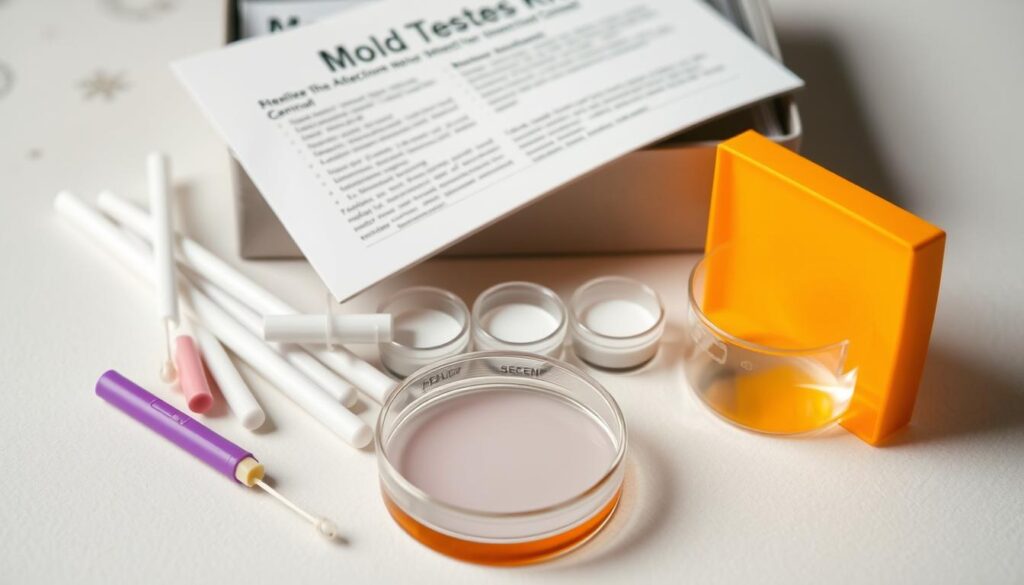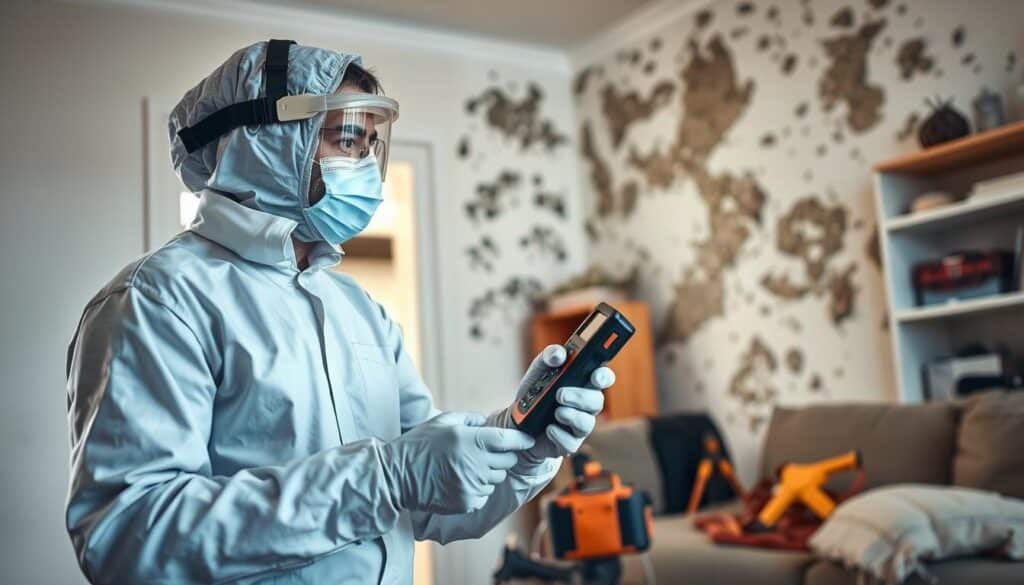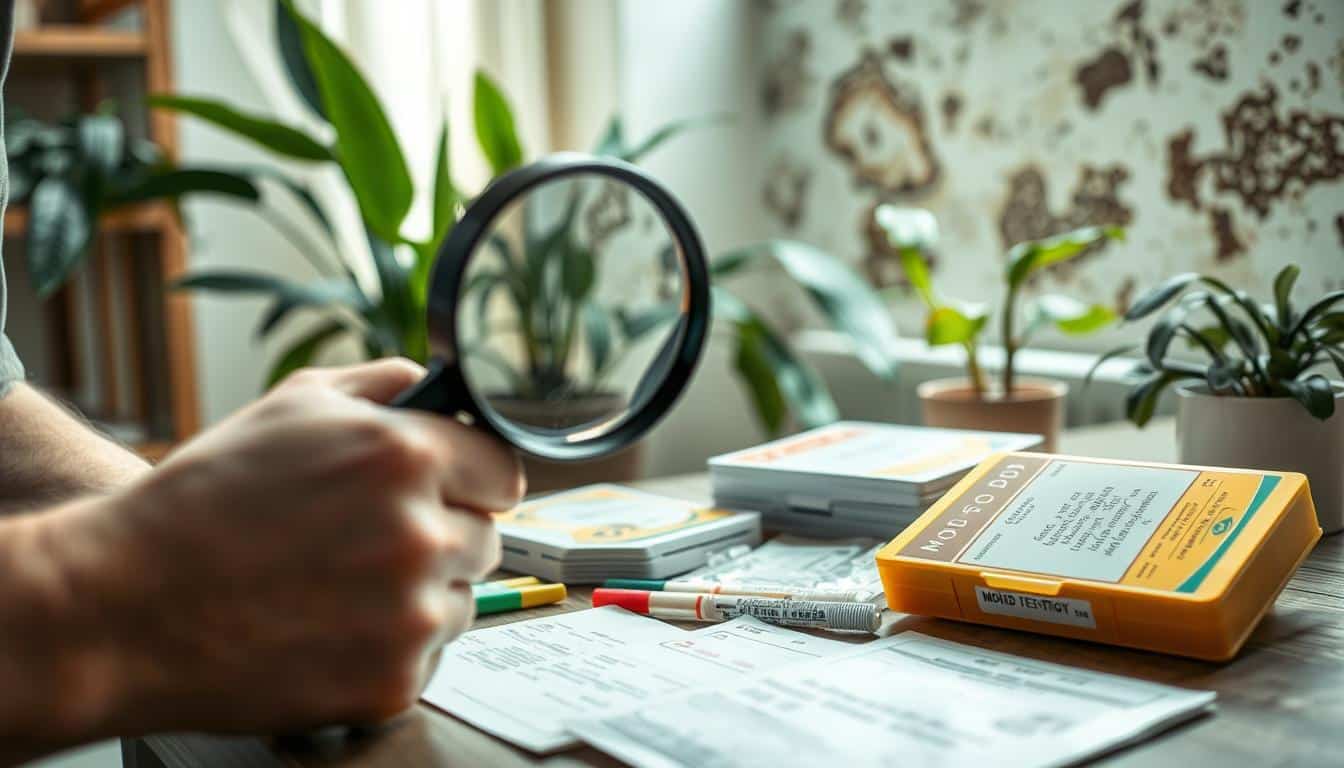Did you know mold can grow almost anywhere? It thrives in warm, moist places between 40 and 100 degrees Fahrenheit. This fact shows why it’s key to know how to test for mold at home. Finding and fixing mold is vital for a healthy home and your family’s health.
In this guide, I’ll show you how to use DIY mold testing kits and professional methods. You’ll learn to spot mold in your home. Knowing about mold types, where they grow, and safety steps will help you tackle mold issues.
Key Takeaways
- Mold can grow in a wide range of temperatures, typically between 40 and 100 degrees Fahrenheit.
- DIY mold testing kits and professional services are available to detect the presence and identify the type of mold in your home.
- Mold requires moisture to thrive, often found in damp, humid areas or triggered by plumbing leaks.
- Proper safety precautions, such as wearing respiratory protection, are essential when testing for and removing mold.
- Addressing moisture issues and improving ventilation are key to preventing future mold growth in your home.
Understanding Mold and Its Dangers
Mold is a common fungus found indoors and outdoors. It grows well in many climates and seasons. The main reason mold grows indoors is too much moisture. This can come from leaks, bad ventilation, or high humidity.
While mold spores are everywhere, some types, like Stachybotrys chartarum, can be harmful. They produce toxins called mycotoxins.
Types of Mold and Their Health Risks
Mold can be black, green, or gray and looks furry or slimy. Being around mold, especially black mold, can cause health problems. These include breathing issues, eye and throat irritation, headaches, rashes, and allergies.
Long-term exposure to toxic mold can lead to serious health issues. How someone reacts to mold can vary. This depends on their allergies and health before exposure.
Common Areas Where Mold Grows in Homes
- Basements and attics with poor ventilation
- Areas around leaks or water damage, such as under sinks or appliances
- Bathrooms with high humidity levels
- Damp, dark spaces with a high cellulose content (wood, drywall, paper, insulation)
Finding mold can be hard. Visual checks and musty smells are better signs than air tests. It’s key to fix mold problems quickly. This includes drying wet areas fast and making repairs.
“Breathing in black mold spores can cause respiratory issues, eye and throat irritation, headaches, rashes, and other allergy-like symptoms.”
Signs That You Might Have a Mold Problem
Spotting the signs of mold is key to fixing it. Mold can harm your health, so watch out and act fast if you see any signs.
Visible Growth and Discoloration
Seeing mold growth is a clear sign of a problem. Look for dark, fuzzy spots or greenish-black marks on walls and ceilings. Mold can also show up as white, gray, or pink. If you see anything odd, check it out.
Musty Odors and Respiratory Symptoms
A musty smell is another sign of mold. This smell often comes with mold, even if you can’t see it. Also, if you or your family keeps getting sick, like coughing or sneezing, it might be mold.
It’s important to tackle these mold signs quickly. Being proactive helps keep your home healthy. This way, you can stop the problem before it gets worse and keep your family safe.
“Mold-infested HVAC systems often emit a musty smell, and mold allergies can manifest as stuffy or runny nose, itchy throat, itchy eyes, skin irritation, and dry skin.”
| Mold Indicator | Description |
|---|---|
| Visible Growth | Dark, fuzzy patches or greenish-black discoloration on surfaces |
| Musty Odors | Distinctive earthy or moldy scent, even in hidden areas |
| Respiratory Symptoms | Coughing, sneezing, shortness of breath, or other respiratory issues |
Preparing for a DIY Mold Test
Before starting your DIY mold test, it’s key to take safety steps. Mold can be harmful, so protect yourself well. Wear gloves, goggles, and a mask or respirator to avoid mold spores.
Next, isolate the area you’ll test. Close the room or space and limit who enters. This keeps the area clean for your test. Always follow the mold test kit’s instructions carefully. This ensures accurate results and keeps you safe.
Recommended Safety Precautions
- Wear gloves, goggles, and a mask or respirator to protect yourself from mold spores.
- Close off the testing area and limit access to prevent disturbance.
- Carefully follow the manufacturer’s instructions for using the mold test kit.
By following these steps, your DIY mold test will be safe and effective. Always prioritize your health and safety when dealing with mold.
How to Use a Mold Testing Kit
Dealing with mold at home can feel overwhelming. But, a mold testing kit can help. These kits have a petri dish with a special culture that grows mold. They let you collect air samples to find mold.
Setting Up the Test Kit
To start, put the petri dish on a flat surface and take off the lid. Let it sit for about 48 hours. This lets mold spores in the air settle on the dish.
Collecting Air Samples
After 48 hours, seal the dish and keep it in a dark place until you send it to a lab. The lab will tell you what kind of mold it is and how much. This helps you know what to do next.
By following the kit’s instructions, you can find out about mold in your home. It’s important to act fast and get help from experts. This helps keep your home healthy and safe.
| Product | Price per Kit | Quantity Discount | Test Methods | Analysis Cost |
|---|---|---|---|---|
| Home Mold Laboratory Viable Mold Test Kit | $12.99 | 6-10 kits: $11.99 each 11+ kits: $10.99 each |
Direct topical samples, air mold spore sampling (2 methods) | $40.00 per kit |

While DIY kits are useful, getting a pro’s help is best for big mold problems. A certified mold inspector can do a detailed check. They’ll suggest the best ways to fix the mold.
Interpreting Mold Test Results
Understanding mold test results means looking at the types of mold and how much is there. The Environmental Protection Agency (EPA) doesn’t pick specific mold test kits. But, the lab results can still tell us a lot about the mold and how to fix it.
Common molds in homes include Penicillium/Aspergillus, Cladosporium, Chaetomium, Basidiospore, Stachybotrys (Black Mold), and Memnoniella. Stachybotrys is especially bad because it can make toxins called mycotoxins. These toxins can be very harmful to our health.
When looking at the results, pay attention to how many mold spores are there. Less than 500 spores per cubic meter (sp/m3) is usually okay. But, more than 500 sp/m3 might mean there’s a mold problem inside.
Also, compare the mold levels inside to outside. If there’s a lot more mold inside, it could mean there’s a mold source in your home.
The lab results might also show hyphal fragments and clumped spores. These signs mean mold is growing nearby. If there’s a lot of these signs, more than 100/m3, it’s a big problem that needs fixing.
By understanding the mold test results, you can figure out what mold is in your home and how bad it is. This info is key to knowing how to deal with the mold.
“Interpreting mold test results involves identifying the types of mold present, the concentration of mold spores, comparing indoor/outdoor ratios, and assessing the locations of mold samples.”
If the test shows a big mold problem, get help from a mold expert. They can make sure it’s fixed right and safely.
When to Call in Professional Mold Inspectors
DIY mold testing kits can be a good start, but there are times when you need professional mold inspectors. If mold covers more than 10 square feet or if tests show dangerous mold, it’s time to call the experts. They can do a detailed mold assessment and find the source of the problem. This helps you choose the right mold remediation steps.
When looking for a mold inspector, find someone with mold certifications and a good reputation. This ensures the job is done right, keeping you and your property safe.
| Scenario | Recommended Action |
|---|---|
| Mold growth exceeds 10 square feet | Call in professional mold inspectors |
| Test results indicate hazardous mold species | Seek professional mold assessment and remediation |
| Persistent musty odors or respiratory issues | Consider a professional mold inspection for hidden mold |
A professional mold inspection costs between $300 to $500, with testing adding $200 to $350. But it’s a smart investment. Experts give valuable advice, make sure mold is correctly found and fixed, and protect your family’s health.

“Exposure to mold can lead to health problems like congestion, wheezing, red or puffy eyes, and more severe reactions when directly exposed to significant amounts of mold.”
Working with certified mold remediation companies helps you tackle mold problems. This prevents more damage and keeps your home healthy for the future.
How to Test for Mold at Home
Step-by-Step Guide for DIY Mold Testing
Testing for mold at home is easy and can spot mold growth early. Here’s how to start:
- Close off the area you want to test and leave it alone for 24 hours. This lets mold spores settle in the petri dish.
- Use the petri dish from your mold testing kit. Remove the lid and let it sit for about 48 hours.
- After the time is up, seal the dish and use tape to keep spores inside.
- Keep the sealed dish in a dark place until you send it to a lab for testing.
It’s key to follow the kit’s instructions for accurate results. The whole process might take a week, but it’s worth it to know about mold in your home.
Remember, checking for mold at home is the first step. If you find a big mold problem, get help from a mold removal expert. They can fix the issue and stop it from coming back.
Preventing Future Mold Growth
To keep your home healthy and mold-free, you need to act early. The best way to stop mold is to fix moisture problems and improve air quality. By controlling moisture and improving air flow, you can lower mold risks.
Addressing Moisture Issues
Mold loves damp, humid places. So, finding and fixing moisture sources is key. Look for water leaks and fix them fast. Make sure your home drains well, clean gutters, and ventilate wet areas like bathrooms and kitchens.
Keep humidity inside your home below 60%. It’s best to keep it between 30% and 50%. This helps stop mold from growing.
Improving Ventilation and Air Quality
Good air flow is vital to stop mold. Use fans in wet areas to remove moisture. Open windows to let fresh air in. Make sure your HVAC system works well and doesn’t add moisture.
Seal air leaks and insulate your home. This helps control humidity and stops mold. By fixing moisture issues and improving air quality, you can keep your home mold-free. Regular checks and care are essential to protect your family’s health.
Mold Remediation Options
If you find mold in your home, you have several options. For small areas, you can try cleaning it with vinegar or baking soda. But for bigger problems or if you can’t find the source, get help from a mold removal company.
Experts have the tools and knowledge to safely remove mold. They also fix moisture issues and teach you how to stop mold from coming back. Since about 70% of U.S. homes have mold, acting fast is crucial.
When looking for mold remediation services, remember that tests and inspections give different info. Inspections find mold, while tests identify the type. Depending on the problem, pros might suggest mold removal and professional mold cleanup for a complete fix.
For DIY mold cleaning, wear protective gear and ensure good air flow. But for big or ongoing mold issues, it’s safer to call a mold remediation pro to avoid health risks.
Quick and effective action can keep your home mold-free and healthy. Remember, mold prevention is key. Fix any moisture problems to stop mold from coming back.
Conclusion
Keeping our homes healthy starts with knowing how to test for mold. Learning about different mold types and spotting early signs helps us act fast. By doing DIY tests, we can find and fix mold problems early.
It’s also important to tackle moisture issues and improve air quality. This helps stop mold from coming back. Preventing future mold growth is key.
When we need help, finding certified experts is crucial. Companies like Mold Remediation USA have the right skills. They follow strict standards to make our homes safe and healthy again.
Understanding mold testing and protecting our air quality is vital. It keeps our homes comfortable and safe for our families. Staying vigilant and taking action is essential for a mold-free home.
FAQ
What are the different types of mold and their health risks?
There are many types of mold, like Stachybotrys chartarum (toxic mold or black mold), Alternaria, and Aspergillus. These molds can release harmful mycotoxins. They can cause allergic reactions and breathing problems.
Where does mold commonly grow in homes?
Mold loves damp places like kitchens, bathrooms, and areas with water damage or bad air flow.
What are the signs that I might have a mold problem in my home?
Look out for visible mold, musty smells, and breathing issues in your family.
What safety precautions should I take when conducting a DIY mold test?
Always wear gloves, goggles, and a mask to avoid mold spores. Make sure to seal off the area and limit access to prevent disturbance.
How do I use a mold testing kit?
Mold testing kits have a petri dish with a microbial culture. Follow the instructions to set it up, wait as directed, and then seal and send it to a lab for analysis.
How do I interpret the results of a mold test?
The lab will tell you if mold is there and what kind. This info helps decide what to do next.
When should I call in professional mold inspectors?
Call professionals if the mold is over 10 square feet or if the test shows dangerous mold. They can do a detailed check and suggest how to fix it.
How can I prevent future mold growth in my home?
To stop mold, fix moisture problems, improve drainage, keep air flowing well, and control humidity.
What are my options for mold remediation?
For small mold spots, you can try cleaning with vinegar or baking soda and water. But for big mold or unclear problems, get a pro mold remediation company.




